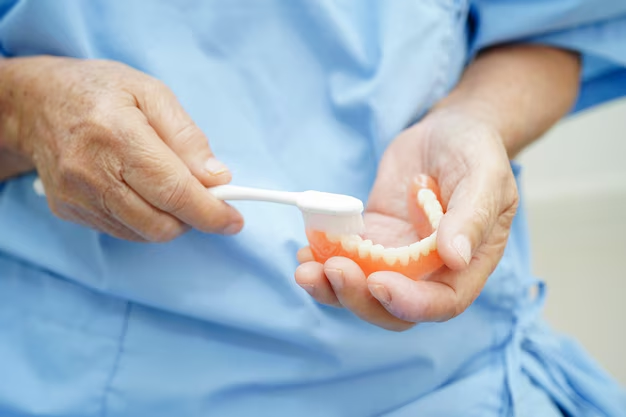Understanding Partial Dentures: What You Need to Know
The world of dentures can be a maze if you're new to it, with various types and options to consider. Among these, partial dentures stand out as a vital solution for those who have lost some, but not all, of their teeth. This article delves into the ins and outs of partial dentures, offering a thorough exploration that aims to inform and clarify the subject for anyone considering this option.
🦷 What are Partial Dentures?
Partial dentures are dental prosthetics designed to replace one or more missing teeth. Unlike complete dentures that replace all the teeth in a jaw, partial dentures fill in the gaps where specific teeth are missing, resting on the gums and attached to the natural teeth through clasps or precise fittings.
Types of Partial Dentures
Removable Partial Dentures: These are designed to be taken out and put back in by the wearer easily. They usually consist of replacement teeth attached to a pink or gum-colored plastic base, which in some cases, is connected by a metal framework to hold the denture in place.
Fixed Partial Dentures (Bridges): Not to be confused with removable types, these are attached to natural teeth or implants through crowns. Once fixed, they function similarly to natural teeth and aren't designed to be removed regularly.
Flexible Partial Dentures: Made from a softer and more flexible material than traditional dentures, these adapt better to your mouth's shape and are less likely to cause irritation.
Benefits of Partial Dentures
🌟 Enhanced Appearance
Partial dentures not only fill in gaps but also restore the natural outline of your face, enhancing your smile and overall appearance.
Improved Oral Functionality
Missing teeth can lead to difficulties in speaking and eating. Partial dentures can significantly improve your ability to chew and speak clearly.
Prevents Teeth Shifting
When you lose a tooth, the surrounding teeth might start to shift and move. Partial dentures help prevent this movement, maintaining your oral structure.
Cost-Effective Solution
Compared to full dentures or extensive dental implants, partial dentures offer a budget-friendly solution for tooth replacement.
🧐 How Are Partial Dentures Made?
The process of creating partial dentures involves several steps:
Initial Consultation: Your dentist will examine your oral health and decide if partial dentures are the right solution.
Impressions & Measurements: Impressions of your mouth will be taken to guide the custom creation of your denture.
Model Creation: A model will be crafted to ensure an appropriate fit and appearance.
Try-In: Before the final denture is made, you'll try a model version to perfect the fit.
Final Fabrication: Once the fit and aesthetics are confirmed, the final denture is created and fitted.
Caring for Your Partial Dentures
Maintaining your partial dentures is crucial for their longevity and your oral health. Here are some key care tips:
- Daily Cleaning: Just like natural teeth, partial dentures require regular cleaning to remove food particles and plaque.
- Avoid Tough Foods: Hard or sticky foods can damage your dentures or dislodge them, so it's best to be cautious.
- Regular Checkups: Regular dental visits are important to ensure that your dentures are fitting well and to check on your overall oral health.
- Handle with Care: When removing or inserting your dentures, do so gently to avoid breaking them.
Challenges and Considerations
While partial dentures offer numerous benefits, there are some considerations to keep in mind:
🌟 Adjustment Period
It's natural for new wearers to take some time to adjust to the feel of dentures in the mouth. Minor discomfort or sore spots might occur initially.
Maintenance Needs
Regular cleaning and maintenance are necessary. Nightly soaking in denture cleaner is a common practice that helps keep them fresh and bacteria-free.
Risk of Damage
Though durable, partial dentures can be susceptible to breakage or wear over time, necessitating repairs or adjustments.
Comparing Partial Dentures to Other Options
| Feature | Partial Dentures | Dental Implants | Complete Dentures |
|---|---|---|---|
| Replaces some teeth | ✅ | ✅ | ❌ |
| Cost-effective | ✅ | ❌ | ✅ |
| Requires surgery | ❌ | ✅ | ❌ |
| Fully removable | ✅ | ❌ | ✅ |
| Longevity | Moderate | High | Moderate |
Frequently Asked Questions About Partial Dentures
🤔 Are Partial Dentures Painful?
Initially, there may be some mild discomfort as your mouth adjusts. However, any persistent pain should be addressed with your dentist.
Can I Sleep with Partial Dentures?
It's typically recommended to remove dentures at night to allow your gums to rest and to perform cleaning.
How Long Will My Partial Dentures Last?
With proper care, partial dentures can last several years, though adjustments or replacements might be necessary over time.
How Do Partial Dentures Affect Eating?
Partial dentures help restore the ability to chew effectively, though some foods might continue to require extra caution.
Empowering You with Knowledge
Understanding partial dentures empowers you to make informed decisions about your dental health. Whether you're considering them for yourself or assisting a loved one, knowing what to expect, how to care for them, and how they stack up against other options can alleviate concerns and prepare you for this transition.
Navigating the world of dentures can indeed seem overwhelming, but with information and guidance, it becomes a manageable and empowering experience. Remember, consulting a dental professional will always provide personalized advice suited to individual needs, paving the way to improved health, comfort, and confidence.

Related Topics
- a Bridge For Teeth
- a Denture Plan That You Can Pay Monthly Payments
- Are Dentures Covered By Insurance
- Are Dentures Covered By Medicare
- Are Dentures Uncomfortable
- Are Permanent Dentures Thinner Than Temporary Dentures
- Are Snap-in Dentures Covered By Insurance
- Are There Plastic Dental Partials With Metal
- Can a Tooth Be Added To a Valplast Denture
- Can Dogs Get Dentures